

This project was a particular surprise for me in that the BC547 (equiv 2N2222) can be used to build a 500mW linear amplifer covering the entire HF band with excelent spectral purity and no neutralising at all. Ugly-bug construction was used but I dare say that the good results are partly to do with the method of construction.
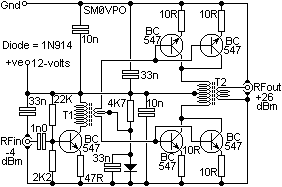
The circuit is fairly straight-forward and does not even need any form of RF neutralising. Two pairs of BC547 transistors are used in a push-pull type of output stage, biassed by a single diode and resistor. The driver is also very conventional using T1 to transform the drive impedance to a very low value for the output pairs. The amplifier is constructed on a piece of copper-clad board 45mm long by 17mm wide. Superglue a 44mm long by 3mm wide strip of copper-clad board along the center. This will become the battery supply rail. Using a sharp knife, remove some copper to form a 3mm x 3mm pad at one end of the battery rail to form the RF output terminal. Next fit the 10n and 33n decoupling capacitors; one pair at either end. These should lay flat on the board. The rest is easy after you see the photographs.
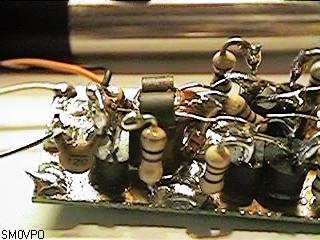
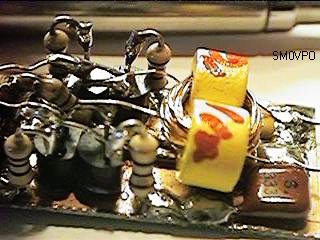
T1 primary is 14-turns of very thin wire (0.1mm Dia.) and the secondary is 1+1 turn of thin wire (0.2mm Dia.). T1 former is two of the smallest ferrite beads I could find. You can just see it in the left-hand photograph above. T1 is composed of two grey ferrite beads. The right-hand photograph shows T2 and the mounting of the two output pairs of BC547 transistors.
T2 is a little special. I found two small ferrite rings in the junk-box and decided to give them a try. The windings are 11-turns triflar wound using thin wire (0.2mm Dia.):
The five transistors are all mounted on their heads using super-glue and with their legs in the air spread wide apart (Hey! this sounds kinda' pornographic!!). The finished linear amplifer does not look very pretty but it is very small. It is less than 10mm high and looks like this. Here you can see it beside my parker pen for comparison (I thought it would be better than a common 1-crown coin).
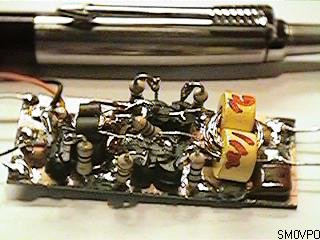
Spectral purity was the biggest surprise; nothing to see on the analyser! Not a single unwanted blip, peak or spurious signal over -30dBm which is about 60dB down on the fundamental. Not bad for "ugly-bug" construction. The amplifer has a 30dB gain so the full output can be achieved when driven from a normal signal generator. Note that Heterodyne generators, such as the Marconi TF995, usually have a very dirty output signal and are not suitable as a driver as the basis of a transmitter; just because it cost you money does not mean it is perfect (as any ham's neighbour owning an Onkyo colour TV will testify). The bandwidth extends well into the VHF region but the gain is almost unity at 100MHz. Here is the spectrum analyser displays. The left-hand photograph shows a sweep of the band from 0-30MHz centered on 15MHz. The input is 17MHz. The right-hand photograph shows the frequency response, scale is also 3MHz/division and the top line is +30dBm (1-watt) on both traces. The scales are logarithmic with 10dB per division.
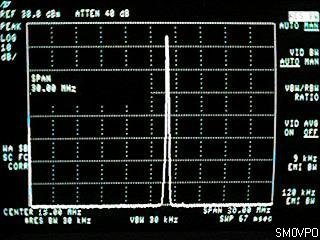
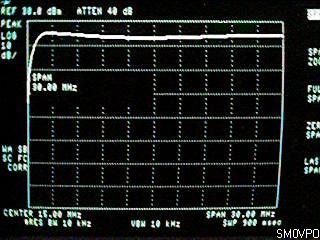
The input level is -4dBm (400uW). As you can see, the gain is reasonably flat and quite usefull from less than 1MHz to well over 30MHz. Ok, so now you have all the information you need to build the linear amplifier yourself. Now that you have got it, what can you do with it? You may want to try:
Please do not ask me silly questions, such as what was the relative humidity and barometric pressure when I wound the transformers or even the density of the ferrite cores I used. I havn't got a clue. It is as you see it, a rather slack-handfull of resistors and the rest from the junk-box. If you use a different type of ferrite then the bandwidth may change a little, maybe not covering medium-wave (add more turns to T1 and T2) or perhaps a lower output in the 35MHz radio-control band (remove a few turns from T1 and T2).
Have fun from Harry, SM0VPO.
